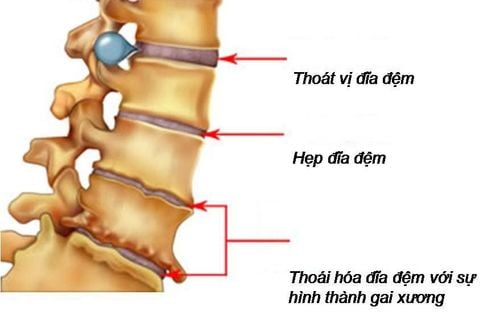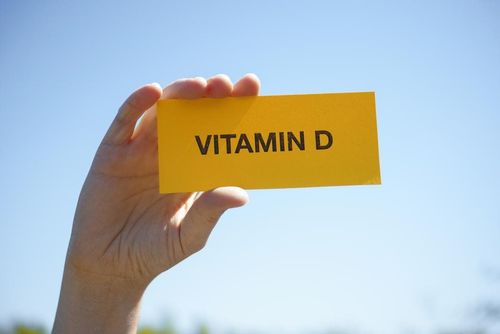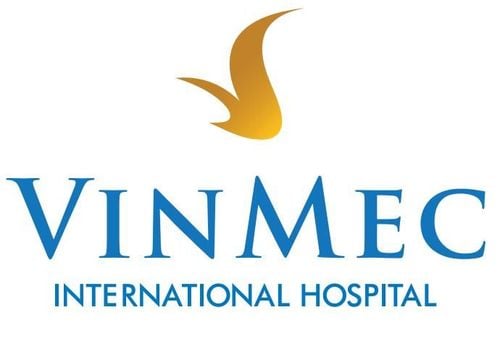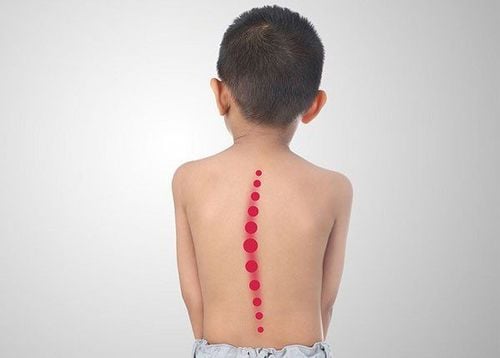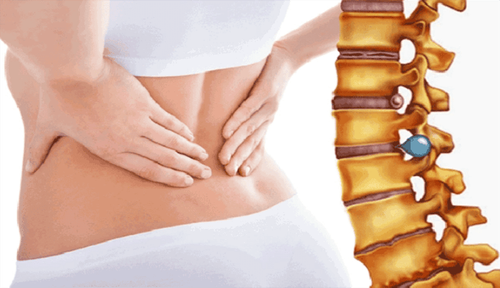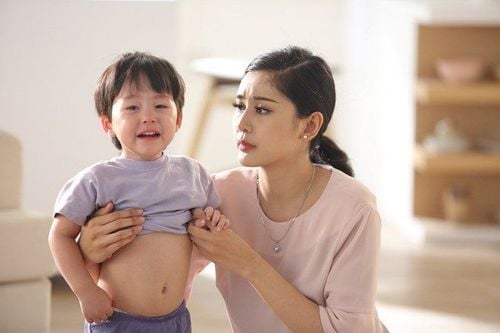This is an automatically translated article.
Scoliosis in children can affect the growth of height, and surrounding organs and organs. Therefore, rehabilitation for children with scoliosis is a necessary method to help children recover and reduce complications.
1. Scoliosis in children
Scoliosis is curvature of the spine to the side of the body axis, curvature of the vertebral bodies along the axis of the horizontal plane. Scoliosis can occur alone or in combination with other spinal deformities, such as kyphosis in the chest, or lumbar arches.
School scoliosis is a problem that many parents are concerned about. Due to the prevalence of 5% of the population, of which 2% need to be treated. About 80% of patients have scoliosis of unknown cause. Some causes lead to curvature of the spine such as:
Congenital scoliosis Spinal trauma Muscle diseases: muscular dystrophy, myasthenia gravis,... Nervous system disease: cerebral palsy, neurofibromatosis, spinal cord disease, polyneuritis,... Improper sitting posture, unequal leg length
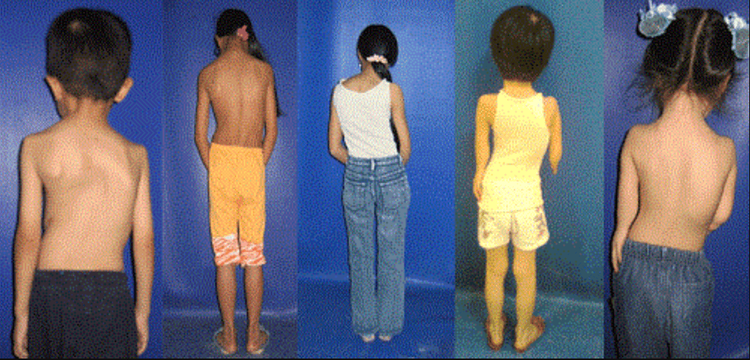
2. Rehabilitation of scoliosis for young children
2.1 Principles of rehabilitation intervention The principles of rehabilitation in scoliosis for children include:
As soon as scoliosis is detected, children need early intervention Intervention techniques Depends on the degree of scoliosis Periodic follow-up with spine X-ray to assess progress. 2.2 Interventional techniques Intervention techniques should be tailored to the degree of scoliosis of each child. Scoliosis curvature based on COBB angle on X-ray film. Measurement is as follows:
Determine the curvature, determine the first and last vertebra of the curvature. Draw a line across the superior border of the superior vertebra and the inferior border of the lower vertebra. Draw two lines perpendicular to the two lines above. Measure the angle created by two perpendicular lines Interventions by degree include:
Mild degree when COBB angle ≤ 20 degrees : Spinal exercises and re-examination every 6 months. Average level when COBB angle = 20 degrees - 45 degrees: Spine brace, spinal exercises and re-examination every 6 months. Severe severity when COBB angle >45 degrees rapidly deteriorates: spine orthopedic surgery. The assessment of COBB angle and indication of interventional technique must be consulted by a neuro-spine or rehabilitation specialist.
Trắc nghiệm: Những điều cần biết về vẹo cột sống
Vẹo cột sống là sự cong vẹo bất thường của cột sống. Có nhiều loại tùy theo nguyên nhân và độ tuổi phát hiện bệnh. Bên cạnh đó, cũng tùy theo mức độ nặng của đường cong, nguy cơ tăng nặng thêm mà áp dụng những phương pháp điều trị khác nhau.
The following content is prepared under supervision of Bác sĩ chuyên khoa I, Thạc sĩ, Đặng Minh Quang , Ngoại chấn thương chỉnh hình , Trung tâm Chấn thương chỉnh hình & Y học thể thao - Bệnh viện Đa khoa Quốc tế Vinmec Times City
2.3 Therapeutic movement exercises Mobility exercises can be performed for children with scoliosis of all ages and different levels of severity:
Exercise 1: Stretching the concave side of the curve in the prone position. The goal of the exercise is to stretch the muscle groups on the concave side of the lumbar curve. Place the child in the prone position. Instruct the child to hold the hand at the low shoulder to the edge of the bed. Raise the legs with your hands, and bring the child's hips to the side opposite the concave side of the lumbar spine. Repeat this movement 10 times. Instruct the child to hold the hand on the low shoulder to the side of the bed and lift up, with the other hand pulling the body toward the foot. Hold this position for a few seconds and repeat 10 times. Exercise 2: Increase the range of motion of the back spine in a sitting position. The goal is to increase the flexion range of the lumbar spine, stretch the back extensor muscle group. Have the child sit with their legs straight and close, arms out in front of them. Instruct children to bring their hands out in front of them to touch their fingers, with their backs bent. Hold this position for a few seconds and repeat 10 times. Exercise 3: Correcting scoliosis in a sitting position. The goal of the exercise is to help stretch the muscles on the concave sides of the curve, increasing the flexibility of the spine. Put the child in the child's sitting position in the chair. Repeat each exercise 10 times. Instruct the child to turn with the object on the side opposite the concave side of the spinal curve. Instruct the child to raise the low shoulder arm high, the other hand to cling to the edge of the chair. Hold this position for a few seconds. Exercise 4: Correcting scoliosis in the four-point kneeling position. The goal is to increase the flexibility of the spine. Place the child in a four-point kneeling position. Bring the child's hand on the concave side of the curve forward and bring the opposite leg up while maintaining the torso position. Hold this position for a few seconds and repeat 10 times. Exercise 5: Correction of scoliosis in standing position. The goal of the exercise is to help stretch the muscles on the concave side of the curve, increasing the flexibility of the spine. Child standing upright. The child's hand on the low shoulder clings to the crossbar to pull himself up, and the opposite shoulder lowers. Hold this position for a few seconds and do the movement 10 times. Exercise 6: Practice deep breathing. The goal is to increase thoracic expansion. Place the child in a semi-recumbent position. The patient's hands are placed under the diaphragm. Teach your child to inhale deeply and exhale slowly. In addition, it is necessary to combine exercise and sports such as swimming

3. Child education and family counseling
Parents are very important people in the child's treatment process. To prevent scoliosis at school, it is necessary to provide health education for children such as:
Schools, young parents need to regularly remind children to sit and study in the correct posture to prevent scoliosis due to posture. Provide the right size study table, suitable for the child's height. Routine physical examination helps in early detection of scoliosis and diseases that can lead to scoliosis in young children. In addition, for children who already have scoliosis, the family needs to explain to the child about their illness, accept and try to overcome the guilt of the illness. On the school side, it is necessary to explain to the students in the school about the disease status of children with scoliosis. From there, the children's friends will sympathize, not mock and help children in learning and playing.
In summary, rehabilitation for children with scoliosis is essential in treating and alleviating complications caused by scoliosis. Scoliosis can make children not grow tall, affecting health, movement, psychology, and later employment. Therefore, it is necessary for school-aged children to periodically examine the spine, in order to detect spine abnormalities early and take timely intervention measures.
Vinmec International General Hospital is a high-quality medical facility in Vietnam with a team of highly qualified medical professionals, well-trained, domestic and foreign, and experienced.
A system of modern and advanced medical equipment, possessing many of the best machines in the world, helping to detect many difficult and dangerous diseases in a short time, supporting the diagnosis and treatment of doctors the most effective. The hospital space is designed according to 5-star hotel standards, giving patients comfort, friendliness and peace of mind.
To register for an examination at Vinmec International General Hospital, you can contact the nationwide Vinmec Health System Hotline, or register online HERE.





